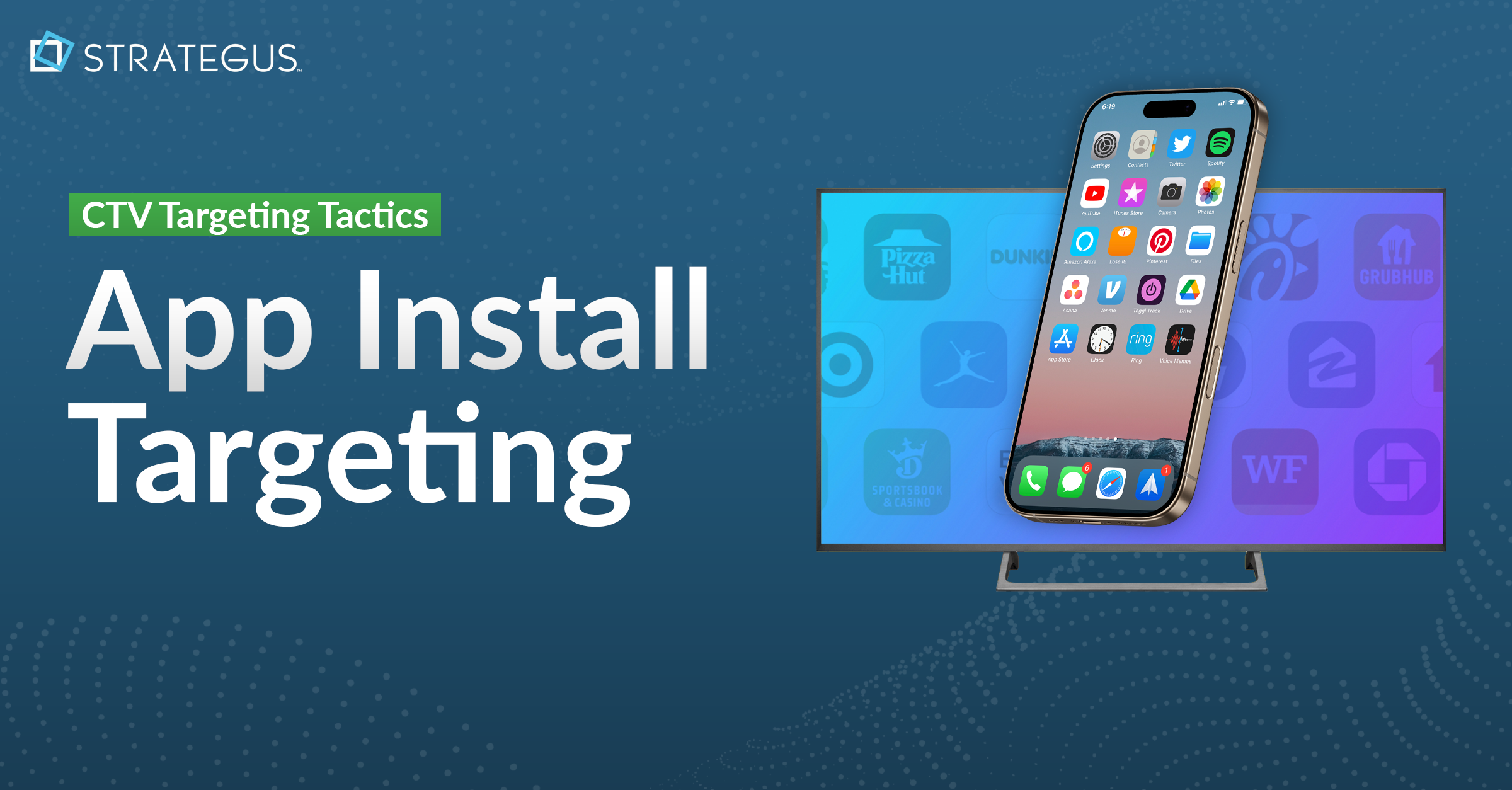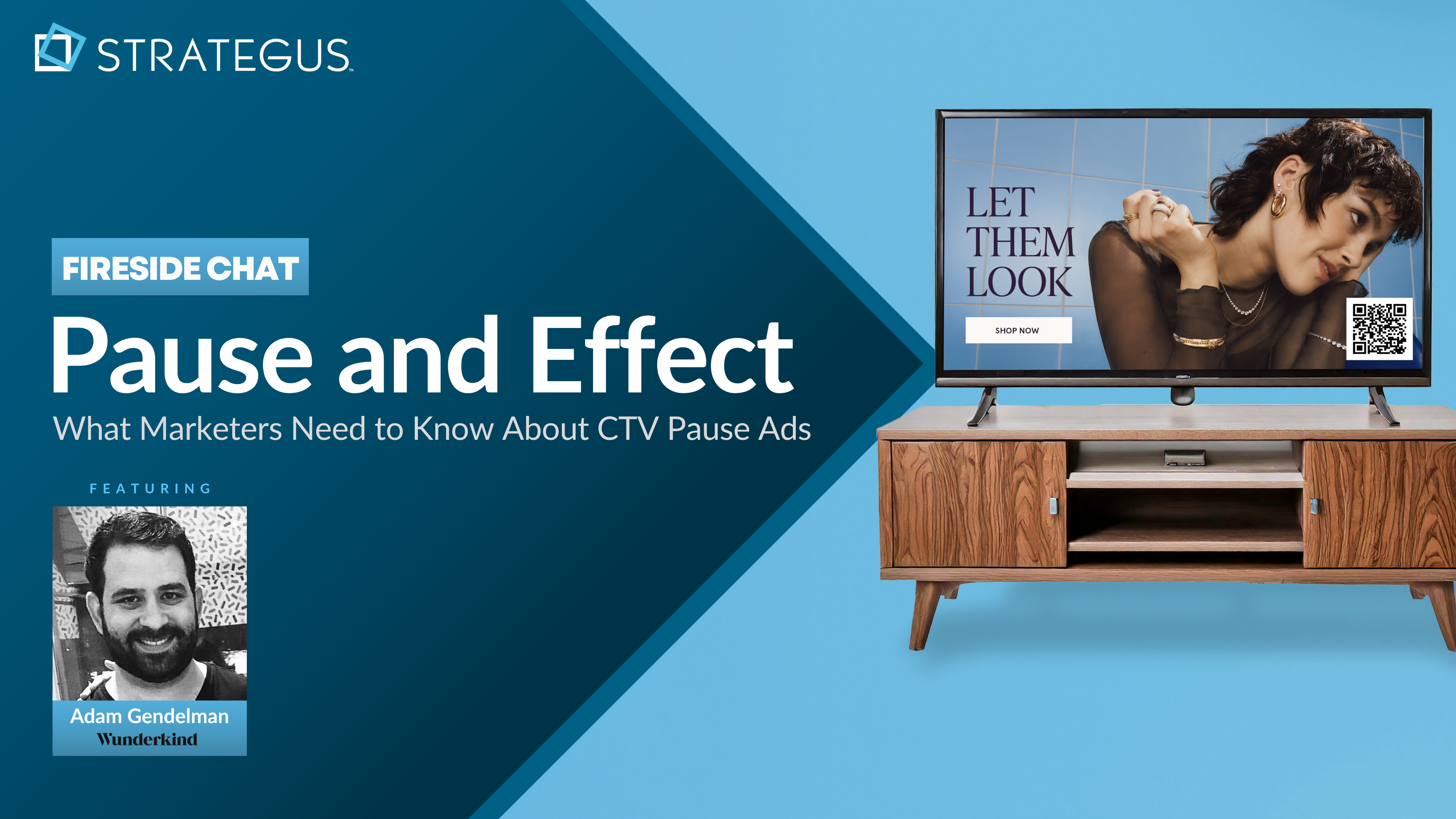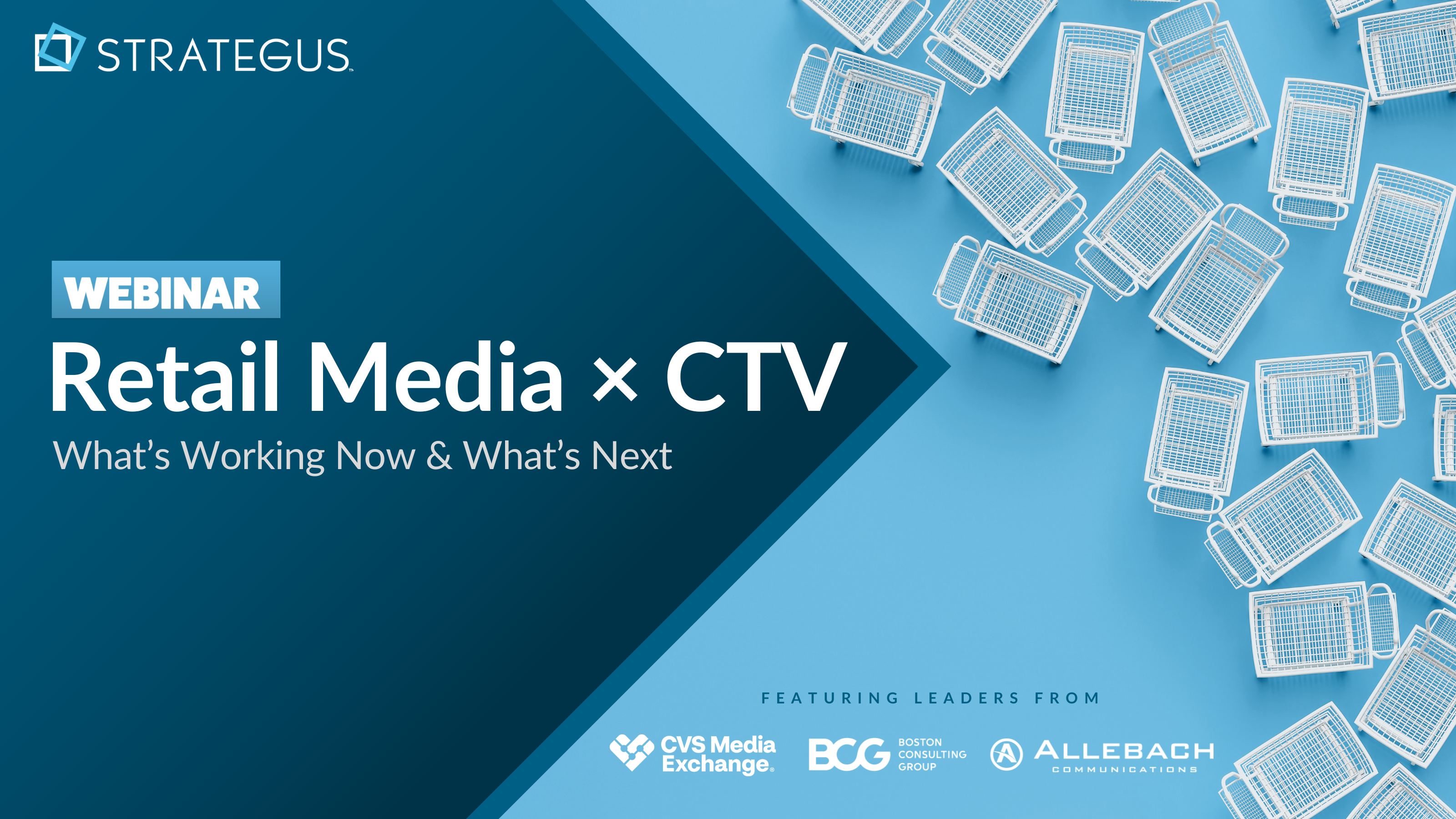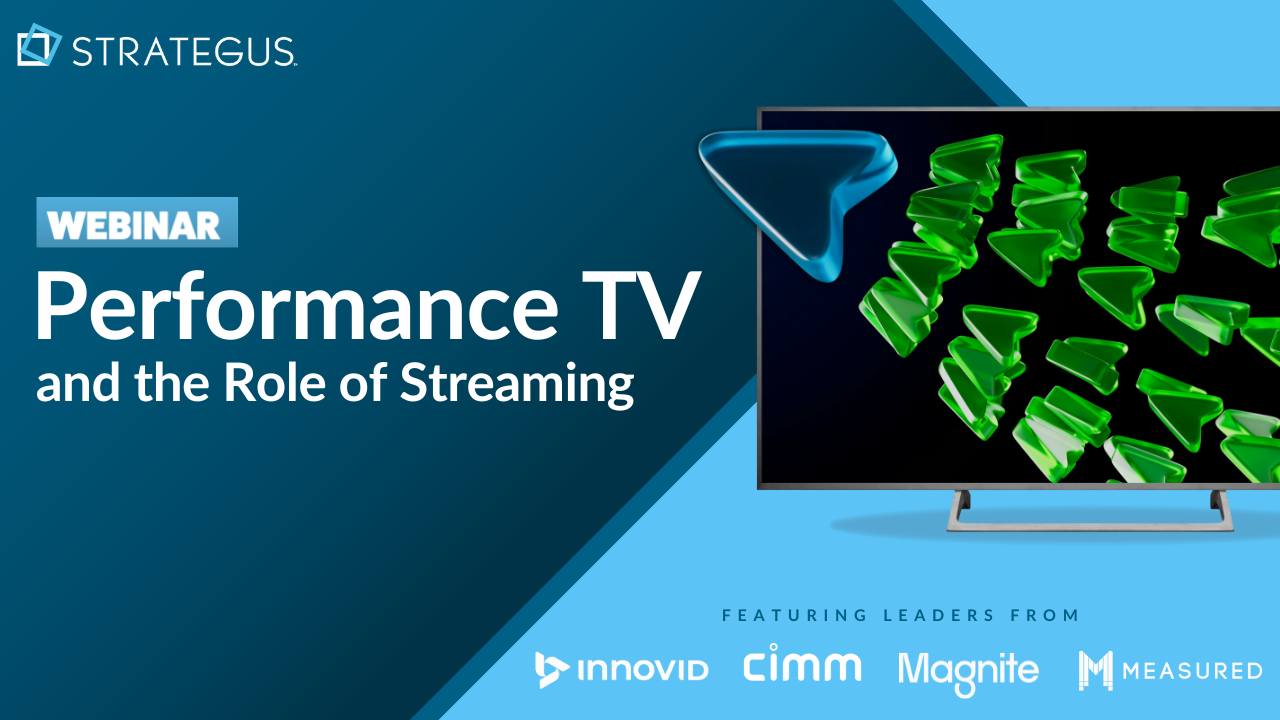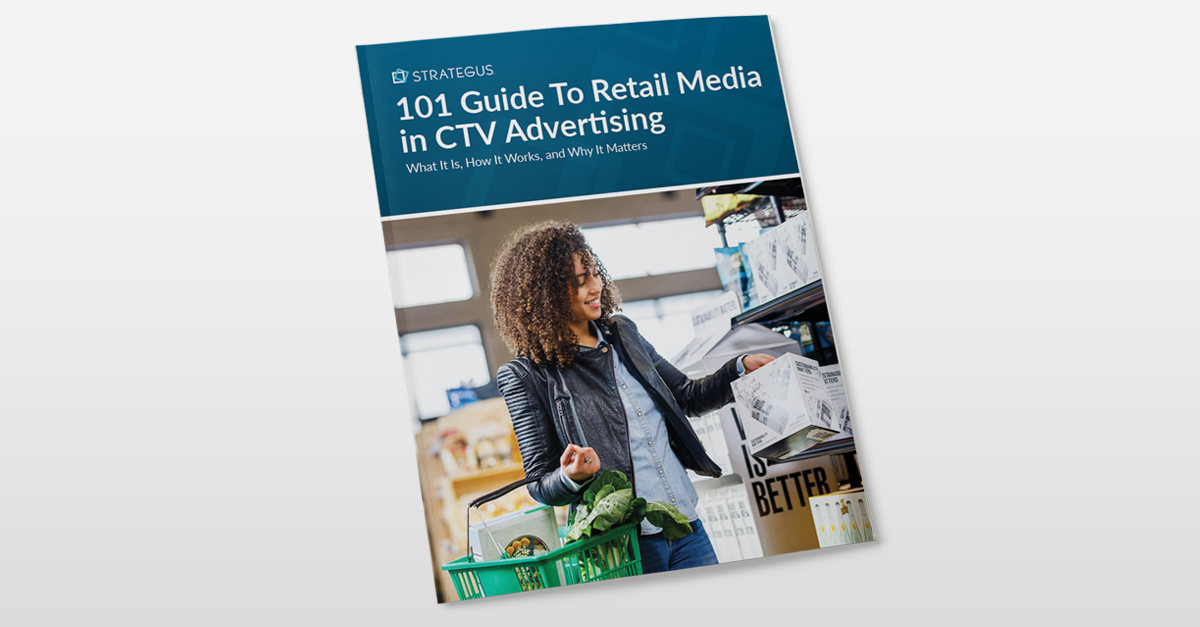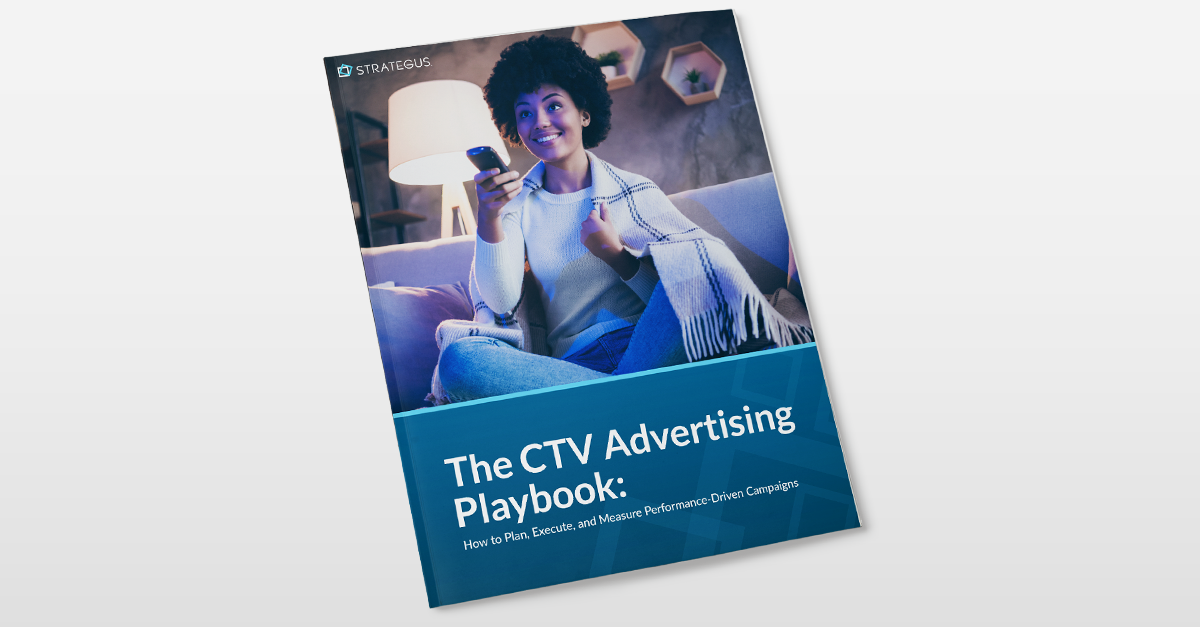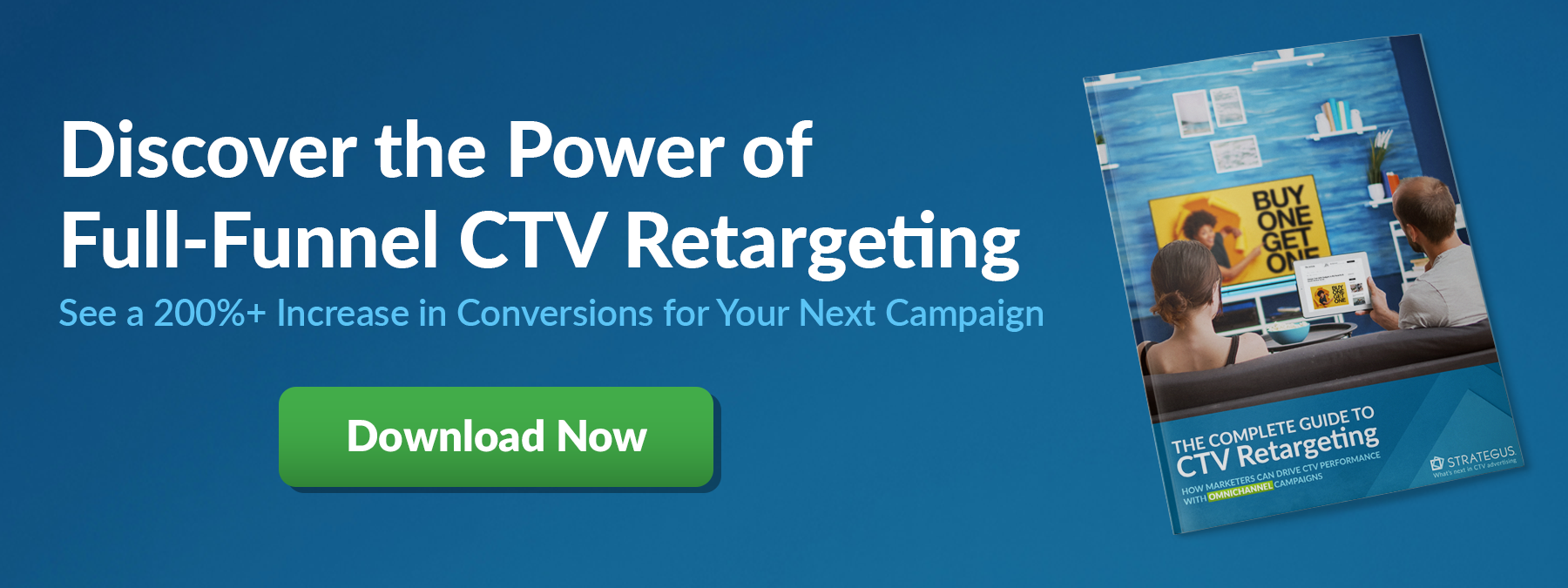- Home
- Strategus Blog
- What is Programmatic TV Advertising and How It Works
What is Programmatic TV Advertising and How It Works
 Traci Ruether
Traci Ruether
17 minutes read
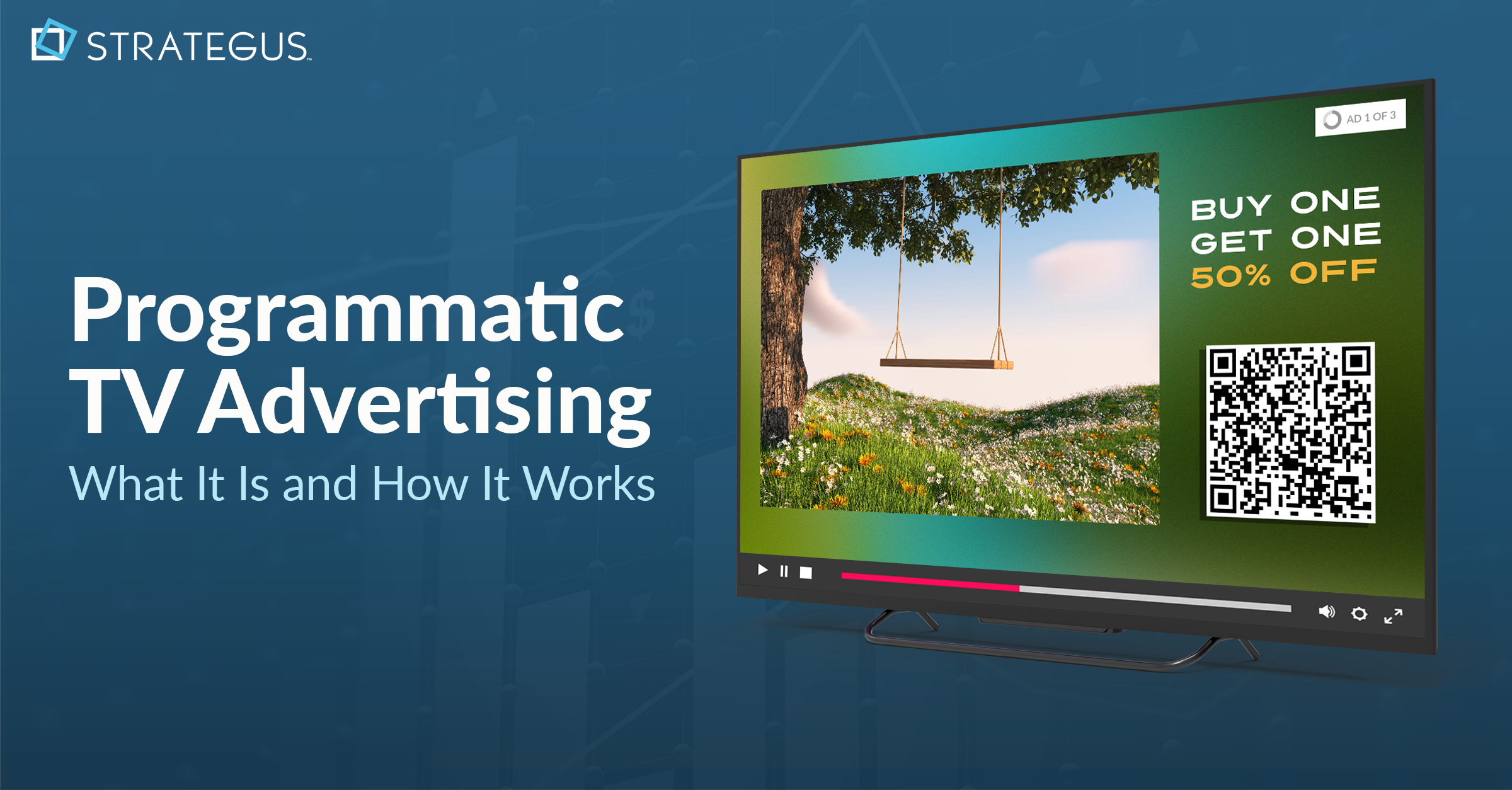
TV viewing is no longer tied to fixed schedules or pricey cable. Streaming made it flexible, and programmatic advertising made it smarter.
Programmatic TV combines traditional reach with digital precision, letting marketers serve targeted, data-backed ads on the biggest screen in the house.
Here’s what it is, how it works and how to use it effectively.
What Is Programmatic TV Advertising?
Programmatic TV is the automated way to buy and sell TV ad space using data and real-time bidding (RTB). Instead of relying on the manual negotiations of traditional TV, it uses algorithms to place ads quickly, efficiently, and with greater precision.
This means less guesswork, less waste, and better results. Advertisers only pay to reach the right audience, and with personalized creative tailored to each segment, they see stronger engagement and higher ROI.
How Are Traditional TV Advertising vs. Programmatic TV Advertising Different?
Programmatic TV advertising sits at the intersection of linear TV and digital advertising, allowing marketers to reach engaged viewers in a targeted and measurable way.
To the undecerning eye, the two may look a lot alike: 15- to 30-second video ads play either before a show begins (pre-roll) or at a commercial break (mid-roll).

But for the advertiser, programmatic TV yields countless benefits.
-
-
It’s Targeted.Rather than having to pay to air a commercial to every Tom, Dick, and Harry watching the nightly news, media buyers are able to precisely target individual households using programmatic ad placement.
-
It’s Content-Agnostic.What’s more, advertisers transacting programmatically can efficiently execute campaigns across the entire CTV ecosystem, achieving the perfect balance of precision and scale.
-
It’s Performance-Driven.Due to their targeted and measurable nature, these ads often go beyond generic awareness plays by incorporating direct-response tactics that motivate viewers to take action.
-
What’s the Difference Between Programmatic CTV and Programmatic Linear TV?
Both use automation, but they serve different ecosystems. Programmatic linear TV buys ad slots during scheduled broadcasts, while programmatic CTV targets viewers on-demand across devices.
CTV offers better targeting, real-time optimization, and measurable results, making it the go-to for performance-focused advertisers.
That said, the technology on legacy TV is nowhere near as sophisticated as that of programmatic CTV, which is why 75% of CTV ads are placed programmatically today.
Advertisers choose based on their goals and audience behavior.
|
Programmatic Linear TV Advertising |
Programmatic CTV Advertising |
|
|
Definition |
|
|
|
Targeting Capabilities |
|
Precise targeting based on interests, behaviors, search history, dietary preferences, the list goes on. Combines first- and third-party data for personalized ad experiences, allowing advertisers to build custom audience using a mix of tactics. |
|
Performance Measurement |
|
Real-time reporting that provides insight into metrics like viewer engagement, ad completion rates, and direct response actions. Additionally, attribution tools can be used to track user activity following exposure. |
|
Use Case |
|
Used for both brand awareness and more performance-based marketing campaigns due to CTV’s ability to be incorporated into full-funnel campaigns. |
|
Cost |
|
|
|
Example |
A direct-to-consumer skincare brand targets women aged 25-54 in urban areas with high disposable income, serving ads during prime-time beauty and lifestyle shows on cable networks like Bravo and E!. Viewers are then encouraged to visit the brand's website or call a specific phone number, and the campaign performance is tracked through website traffic increases and call center volume during and after the ad airings. |
A direct-to-consumer skincare brand targets women aged 25-40 who have recently searched for skincare products online, serving ads during popular streaming shows across a vast range of streaming platforms like Amazon Prime, Pluto TV, and Sling. Viewers are then served subsequent ads across display, search, and social through CTV retargeting tactics, and the campaign performance is tracked holistically at every step. |
How Does Programmatic TV Advertising Work?
Programmatic CTV is entirely addressable, which means advertisers can specify the households that see their ads rather than having to pay to reach every viewer tuning into a given broadcast. This is achieved using an automated process of real-time bidding to identify specific households.

Here’s a breakdown of the process:
- Data collection: Data is collected from various sources, such as first-party CRM data, Amazon purchase data, and connected TV viewing data. These sources are combined to provide information about viewers’ demographics, interests, and viewing habits.
- Audience segmentation: Using this data, advertisers segment their audience into different groups based on their characteristics and interests. This allows them to create targeted ads that are more likely to resonate with each group.
- Ad delivery: Once the audience is segmented, the targeted ads are delivered to specific households through their CTV screens. These ads run during streaming content like on-demand shows on Amazon Prime, live sports broadcasts on YouTube TV, and must-watch TV shows on DirecTV Stream.
- Measurement and optimization: Advertisers can then track the performance of their ads and make adjustments based on the data collected. This paves the way for continuous optimization that can be done on the fly.

What are the Benefits of Programmatic CTV Over Traditional TV Advertising?
The benefits of programmatic CTV are tied to how its data-driven attributes give marketers the ability to link these campaigns to tangible business results.
The IAB Digital Video Ad Spend & Strategy Report confirmed as much, revealing that business outcomes like store visits and website actions are now the most important KPIs for media buyers investing in CTV.
Chris Brugerle, the IAB’s VP of industry insights and content strategy, elaborates:
“We’re in a performance world now. We are in a ‘don’t waste your dollars’ market. And business outcomes are more important than they’ve ever been.”
Here’s a look at how programmatic CTV meets these needs.

Hypertargeted and Localized
Unlike the spray-and-pray approach of traditional TV advertising, streaming lets marketers pinpoint their audience in a fully customized manner. Trying to reach foodies? With CTV advertising, you can serve commercials specifically to gluten-free, vegetarian, or keto viewers within a specific geographic area.

Personalized and Relevant
Programmatic CTV allows brands to reach the right people, at the right time, with the right message by customizing the ad creative based on which customer segments are being targeted.

Full-Funnel Retargeting
CTV campaigns can be linked to cross-device retargeting strategies that drive conversions across supplementary channels. For instance, the same person who sees a CTV ad for a local health food store can be retargeted with a banner ad while browsing online.
Measurement and Attribution
The digital nature of online video provides marketers with access to a ton of data. For this reason, programmatic CTV ads help tie marketing dollars to quantifiable outcomes — such as how many people made online purchases, visited a brick-and-mortar location, or researched the advertised products following ad exposure.
Cost-Effective
Old-school TV advertising was only feasible for big businesses with even bigger budgets. That’s not the case with programmatic CTV. Because these ads are purchased on a per-viewer basis, marketers only have to pay for actual views using cost-per-mile (CPM) rates. This has helped democratize the medium, making it a feasible channel for small local businesses.

Ongoing Optimization
Programmatic CTV is dynamic and can be changed on a dime. While a “set it and forget it” mentality leads to missed opportunities, taking a more proactive approach can help brands nail down a formula for success through iteration.
Obviously, this requires time and resources that not all marketers have. But there’s always the option to enlist the help of a managed services partner like Strategus to take care of the day-to-day details of maximizing CTV success.
Programmatic TV Advertising Best Practices You Must Know
While automated ad delivery helps speed up the manual processes of media placement, advertisers still need to approach programmatic CTV strategically.
We’d recommend prioritizing the following best practices when getting started.
- Define campaign goals and target audiences: The first step to crafting a CTV campaign is defining your goals (e.g., brand awareness, website visits, foot traffic to a brick-and-mortar location) and target audience segments. This will lay a foundation for more targeted and actionable campaigns.
- Gather existing video assets: Next, assess your existing video library. Look for high-quality, on-brand content that aligns with CTV's technical requirements. This includes professional production value, clear branding throughout, a singular focus on a key message, and clean design with easy-to-read text and contrasting colors for optimal viewing on large screens.
- Update what you have or build CTV-first creative: Whether you’re updating existing video assets or creating new ads from scratch, it’s all about giving users a clear call to action based on your campaign goals. Some tactics for doing this include promoting current deals, showcasing your current inventory with dynamic creative, or incorporating interactive elements like QR codes that drive action.
- Personalize messaging to different audiences: The key to CTV advertising is delivering relevant ads that resonate with viewers. As such, tailoring ad creative to different buyers drives better results. This could mean swapping out the B-roll or highlighting different products and services.
- Nail the basic requirements and specs: Align with technical specs for the length (15 or 30 seconds), file format (MP4), and resolution (1080 p). Failure to meet these specs can cause latency and buffering, potentially causing viewers to abandon the app or even reboot their devices.
- Put guardrails in place to prevent ad fatigue: Rotate at least 3 creative variations can help prevent ad fatigue, as well as refreshing your ads quarterly. You’ll also want to monitor campaign frequency and engagement to adjust your strategy based on what the data shows.
- Integrate your CTV ads into full-funnel campaigns: Expand your reach and boost conversions by layering retargeting efforts across various channels like display ads, paid social media ads, and paid search ads. This allows you to deliver targeted messages throughout the customer journey, from initial brand awareness to website visits and ultimately, conversions.
- Test and optimize campaigns in flight: Just like other digital channels, programmatic CTV campaigns should be monitored and optimized on an ongoing basis.

How to Choose a Programmatic CTV Partner
You have two options when approaching CTV: a self-serve DSP, where your team handles everything, or a managed service partner like Strategus, where experts manage the heavy lifting.
Self-serve gives you full control but requires in-house expertise, multiple platform integrations, and constant oversight. This model works best for organizations that are fully resourced and experienced in CTV.
If that’s not you, a managed service provider can simplify execution and maximize performance through end-to-end support.
Here’s how the two compare:
Our Co-Founder and EVP of Innovation, Joel Fox, explains:
What to Look for in a CTV Advertising Partner
Choose a partner that provides transparency, reach, and real results. Key criteria include:
- Data Capabilities: Must support first-party data, advanced audience segmentation, and cross-device tracking.
- Attribution & Reporting: Look for real-time dashboards and multi-touch attribution to track ROAS.
- Inventory Access: Ensure they offer premium, cross-platform inventory across top CTV publishers.
- Creative Support: Should deliver personalized, dynamic creatives tailored to each audience segment.
- Service Model: Pick based on your team’s bandwidth — whether you need hands-on control or a full-service partner.
- Compliance & Privacy: Confirm adherence to data privacy laws like GDPR and CCPA.
Don’t Overlook Inventory Breadth
Your provider’s inventory reach impacts how many viewers you can access. Relying on a single DSP limits your scale.
Also, be cautious of walled gardens like Google or Amazon. While they’re easy to start with, they often lock you into a closed ecosystem, reduce transparency, and restrict campaign flexibility.
Ask These Questions Before You Commit
- Who are your key data and tech partners?
- Can you share a breakdown of your inventory sources?
- How is your offering different from other CTV platforms?
- What attribution tools do you support?
- How do you go beyond age and gender in audience targeting?
Get Started With Strategus
Looking to launch smarter CTV campaigns or optimize your current strategy? Strategus delivers precision, scale, and real results through programmatic CTV.
Here’s what sets us apart:
- Premium Reach: Access 200+ top publishers and over 843 curated deal IDs.
- Proven Experience: First to run a programmatic CTV campaign back in 2015.
- CTV-Only Focus: Deep expertise in strategy, execution, and optimization.
- Custom Campaigns: Built around your goals, audience, and creative.
- Full-Service Support: We manage everything so you can stay focused.
- Transparent Results: Real-time reporting and ongoing optimization.
Ready to make every impression count?
Contact us to get started today.
Frequently Asked Questions
What Types of Businesses Benefit Most from Programmatic TV Advertising?
Programmatic TV works well for both large brands and small businesses. National advertisers gain scale and targeting, while local businesses can reach niche audiences affordably. It’s especially useful for eCommerce, auto, healthcare, and retail brands that want measurable outcomes from TV campaigns.
How Much Does Programmatic TV Advertising Cost?
Costs vary by targeting, placement, and inventory quality. Programmatic CTV typically runs on a CPM basis, ranging from $20 to $50. It’s more affordable than traditional TV because you only pay for impressions delivered to your exact audience.
What Platforms Support Programmatic TV Advertising?
Programmatic TV campaigns can run on platforms like YouTube TV, Hulu, Sling, Roku, Amazon Freevee, and Pluto TV. Ads are served through demand-side platforms (DSPs) that connect with multiple publishers, allowing wide reach across premium streaming content.
What Creative Assets Do I Need for Programmatic TV Campaigns?
You’ll need high-quality, short-form video ads—typically 15 or 30 seconds—formatted in MP4 with 1080p resolution. Creative should feature clear branding, a focused message, and a call to action. For best results, tailor messaging to different audience segments.
How is Programmatic TV Measured?
Advertisers track impressions, ad completion rates, click-throughs, site visits, conversions, and offline actions. Tools like attribution models, device graphs, and first-party data help tie views to outcomes, enabling real-time campaign adjustments and clear ROI reporting.
What is Programmatic TV Buying?
Programmatic ad buying refers to the automated purchase of digital ad inventory using real-time bidding and data targeting. It allows marketers to buy impressions across websites, apps, and streaming services with greater precision and speed compared to manual ad buys.
How Do I Buy Programmatic TV Ads?
You can buy them via a demand-side platform (DSP) or through a managed service provider like Strategus. Define your target audience, upload video assets, set your budget, and launch your campaign. The platform handles targeting, bidding, and placement across premium CTV inventory.
Is CTV Advertising Programmatic by Default?
Not always. CTV ads can be bought directly or programmatically. However, most CTV inventory is now purchased programmatically because it allows for better targeting, measurement, and performance optimization. Over 75% of CTV ads are placed this way today.
What is a Programmatic Campaign?
A programmatic campaign uses automated platforms to buy and place digital ads. It involves targeting specific audiences, bidding for impressions in real time, and optimizing based on performance. Programmatic campaigns can run across CTV, display, mobile, and social media.
Why Choose a Managed Service for Programmatic TV?
A managed service provider like Strategus handles everything—strategy, creative, bidding, optimization, and reporting. This removes complexity, saves time, and improves performance, especially for teams without in-house programmatic expertise. It’s ideal for brands that want full-funnel results without managing daily execution.

Traci Ruether is a content marketing consultant specializing in video tech. With over a decade of experience leading content strategy, she takes a metrics-driven approach to storytelling that drives traffic to her clients' websites. Follow her on LinkedIn at linkedin.com/in/traci-ruether or learn more at traciruether.com.
Strategus is a managed services connected TV(CTV) advertising agency with over 60,000+ campaigns delivered. Find out how our experts can extend your team and drive the result that matter most.
Talk to an Expert
Table of Contents
Seeking a Custom CTV Strategy That Delivers?
What to read next
App Event Tracking: Tie Mobile App Activity to CTV Campaigns
Let’s say you’re running a CTV campaign for a personal finance app.
5 minutes read

Stop Guessing Who Your Audience Is — Let Their Apps Tell You
Connected TV (CTV) targeting often falls in one of two camps.
8 minutes read
See Who Bought After Your Ad + How Much They Spent
You can’t improve what you can’t measure. And for years, that’s been a major problem with TV advertising.
4 minutes read

First-Party Attribution: Match Ads to Sales With CRM Data
The value of first-party data continues to grow.
7 minutes read



